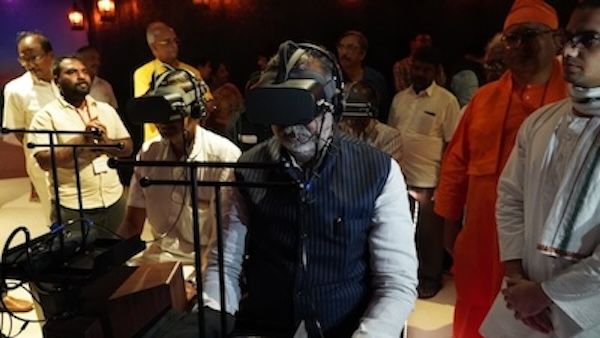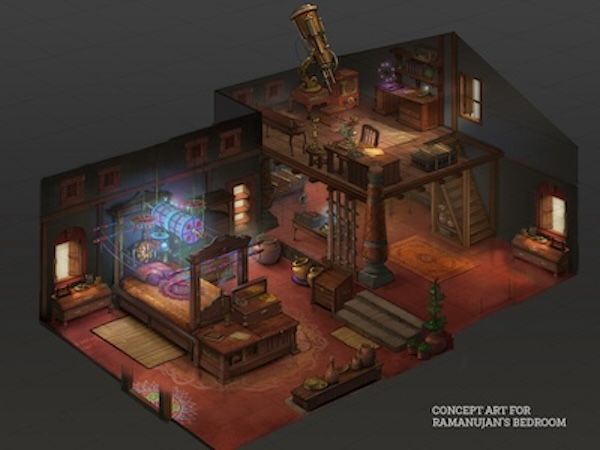In India, technology is still viewed as a tool for delivery or advertisement rather than an artform itself. Classical Indian art with origins dating back thousands of years has a significant contemporary presence that connects the cultural identity of the country from religious practice to lifestyle norms. Only in the past 100 years has classical art such as music and dance been rendered in digital forms.
3 Mergers of Art and Tech in India
- Vivekananda House, a historic site and museum in Chennai with tech-powered exhibitions detailing the life of Swami Vivekananda
- Antariksha Sanchar, a video game that combines math, mythology and classical dance
- Homegrown, an electronic magazine that explores art in the digital space
While the wide-scale use and appreciation of tech art such as video art, holographics, virtual reality and augmented reality or even artificial intelligence may be far off, some establishments are venturing into these modes of holistic craft. Here are three examples.
VR/AR at Vivekananda House
The Vivekananda House is a historical building dedicated to Swami Vivekananda, a disciple of the Hindu monk Sri Ramakrishna Paramahamsa. The colonial building has a museum that details the life of Vivekananda, with exhibitions ranging from paintings and sculpture to a VR and AR space that has 4D effects.

Religious institutions like Ramakrishna Math, which support the Vivekananda House and Sadhguru’s Isha Foundation, robustly invest in tech infrastructure to grow their missions. They understand that their audiences have a digital persona that must be engaged with just as much as the real-life person. This evolution of spiritual engagement has developed overseas as well with organizations like ISKCON, the International Society for Krishna Consciousness, in New York, establishing digital communities where members can connect despite distance.
Religion tech, digitized platforms that enable people to practice, spread and organize their faith, plays an important role in how India engages with art. In a country with fervent spiritual practice and ritual exhibition, religious organizations define the boundaries of what is culturally appropriate to connect with. Vivekananda House articulating the words of a saint through an artificial reality experience revolutionizes cultural education and, thanks to its pioneering adoption, encourages other organizations to follow suit.
Antariksha Sanchar: Sci-Fi Video Game
Antariksha Sanchar, which means universe travel or space transmission, is a speculative science fiction video game that uses immersive audio visuals to converge contemporary and ancient art. Artists from different fields, electronic music, classical South Indian music and dance, graphic designers and video game developers, designed an experimental narrative that questions conceptual and physical norms of art and play.

Jayalakshmi, the dance lead on the project, describes the mission of the art piece as “two different generations trying to come together using this present generation’s tastes.” The music producer Murthovic agrees. “It’s difficult to come out as a house and techno and electronic music producer and approach classical music,” Murthovic says. “I’ve had to internalize a new sort of routine for myself. Now I wake up to a shruti (musical notes) or a new raaga (melody) that I need to learn.”
Designers who bridge these multidimensional art forms are on the rise and change is imminent. Their emphasis on physical materiality and biological sensory stimulation has both audiences and artists in a transitional state of understanding how and what technology can bring to India’s bountiful art landscape.
Homegrown Magazine
Electronic publications have also become a way to access and be exposed to explorative art in the digital space. Homegrown, an e-magazine “catering to the interests of the modern Indian,” collaborated with John Dewar and Sons’s Dewar’s Experiences, a subrand of the whisky company that curates events under the tag Dewar’s Stay Curious. The series promises “multi sensorial traveling through an immersive odyssey.”
A recent event in Bangalore proved to be another example of integrating the popular and traditional with the emergent. Featured artists included DJ Murthovic and mridangam player Raghu Ram Hari, who also worked on Antariksha Sanchar.
These in-person events featured wall-size immersive and responsive audio visuals; performances combining music, physical movement and light choreography; and art installations and acoustic performances. The performances are designed to urge self discovery, question traditional methodology and simply bring unseen works to light.
Indian artists and expats share the sentiment that India could develop into an exceptional playground for the intersection of art and technology. They see the lack of development in the Indian art market, valued at $700 million, as an opportunity to be accountable for the next generation’s experiences. Working artists would rather take their time and build something using their own community and heritage rather than rely on sources outside of the country to guide their development.
Shiv Gupta, DJ and organizer of the now-defunct GO:MADras electronic music festival (it ended due to the pandemic), prefers the slow pace. Gupta is based in Chennai, but often travels some 560 miles northwest to make art in Goa. “I like Goa because it’s like 20 years behind. It’s still a village in all respects,” he says. “I feel like I can restart and make a change there and bring in all that technology.”





